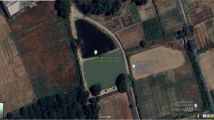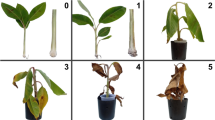Abstract
Metarhizium robertsii is a fungus with two lifestyles; it is a plant root symbiont and an insect pathogen. A spontaneously phenotypically degenerated strain of M. robertsii strain ARSEF 2575 (M. robertsii lc-2575; lc = low conidiation) showed a reduction in conidiation and fungal virulence after successive subculturing on agar medium. In order to recover conidiation, we experimentally passaged M. robertsii lc-2575 through plant (soldier bean and switchgrass) root or insect (Galleria mellonella) larvae. After five passages, the resultant strains had significantly increased conidial yields on agar and increased virulence in insect bioassays. Concomitantly, DNA methyltransferase, MrDIM-2 expression was downregulated in BR5 (a strain after 5 bean root passages) and isolates after switchgrass and insect passages. Bisulfite sequencing showed little difference in overall genomic DNA methylation levels (~ 0.37%) between M. robertsii lc-2575 and BR5. However, a finer comparison of the different methylated regions (DMRs) showed that DMRs of BR5 were more abundant in the intergenic regions (69.32%) compared with that of M. robertsii lc-2575 (33.33%). The addition of DNA methyltransferase inhibitor, 5-azacytidine, to agar supported the role of DNA methyltransferases and resulted in an increase in conidiation of M. robertsii lc-2575. Differential gene expression was observed in selected DMRs in BR5 when compared with M. robertsii lc-2575. Here we implicated epigenetic regulation in the recovery of conidiation through the effects of DNA methyltransferase and that plant passage could be used as a method to recover fungal conidiation and virulence in a phenotypically degenerated M. robertsii.
Key points
• Passage of Metarhizium through plant root or insect results in increased conidiation.
• DNA methyltransferase is downregulated after host passage.
• Bisulfite sequencing identified potentially methylated genes involved in conidiation.





Similar content being viewed by others
References
Albertyn J, Hohmann S, Thevelein JM, Prior BA (1994) GPD1, which encodes glycerol-3-phosphate dehydrogenase, is essential for growth under osmotic stress in Saccharomyces cerevisiae, and its expression is regulated by the high-osmolarity glycerol response pathway. Mol Cell Biol 14:4135–4144. https://doi.org/10.1128/mcb.14.6.4135
Behie SW, Bidochka MJ (2014) Ubiquity of insect-derived nitrogen transfer to plants by endophytic insect-pathogenic fungi: an additional branch of the soil nitrogen cycle. Appl Environ Microbiol 80:1553–1560. https://doi.org/10.1128/AEM.03338-13
Behie SW, Zelisko PM, Bidochka MJ (2012) Endophytic insect-parasitic fungi translocate nitrogen directly from insects to plants. Science 336:1576–1577. https://doi.org/10.1126/science.1222289
Behie SW, Moreira CC, Sementchoukova I, Barelli L, Zelisko PM, Bidochka MJ (2017) Carbon translocation from a plant to an insect-pathogenic endophytic fungus. Nat Commun 8:14245. https://doi.org/10.1038/ncomms14245
Bhanu Prakash GVS, Padmaja V, Siva Kiran RR (2008) Statistical optimization of process variables for the large-scale production of Metarhizium anisopliae conidiospores in solid-state fermentation. Bioresour Technol 99:1530–1537. https://doi.org/10.1016/j.biortech.2007.04.031
Bischoff JF, Rehner SA, Humber RA (2009) A multilocus phylogeny of the Metarhizium anisopliae lineage. Mycologia 101:512–530. https://doi.org/10.3852/07-202
Bock C, Lengauer T (2008) Computational epigenetics. Bioinformatics 24:1–10. https://doi.org/10.1093/bioinformatics/btm546
Butt TM, Wang C, Shah FA, Hall R (2006) Degeneration of entomogenous fungi. In: Eilenberg J, Hokkanen Heikki (eds) An ecological and societal approach to biological control. Springer Netherlands, Dordrecht, pp 213–226
Callejas-Negrete OA, Torres-Guzmán JC, Padilla-Guerrero IE, Esquivel-Naranjo U, Padilla-Ballesteros MF, García-Tapia A, Schrank A, Salazar-Solís E, Gutiérrez-Corona F, González-Hernández GA (2015) The Adh1 gene of the fungus Metarhizium anisopliae is expressed during insect colonization and required for full virulence. Microbiol Res 172:57–67. https://doi.org/10.1016/j.micres.2014.11.006
Chen X, Xu C, Qian Y, Liu R, Zhang Q, Zeng G, Zhang X, Zhao H, Fang W (2016) MAPK cascade-mediated regulation of pathogenicity, conidiation and tolerance to abiotic stresses in the entomopathogenic fungus Metarhizium robertsii. Environ Microbiol 18:1048–1062. https://doi.org/10.1111/1462-2920.13198
Diot A, Morten K, Poulton J (2016) Mitophagy plays a central role in mitochondrial ageing. Mamm Genome 27:381–395. https://doi.org/10.1007/s00335-016-9651-x
Fang W, Bidochka MJ (2006) Expression of genes involved in germination, conidiogenesis and pathogenesis in Metarhizium anisopliae using quantitative real-time RT-PCR. Mycol Res 110:1165–1171. https://doi.org/10.1016/j.mycres.2006.04.014
Fang W, St Leger RJ (2010) Mrt, a gene unique to fungi, encodes an oligosaccharide transporter and facilitates rhizosphere competency in Metarhizium robertsii. Plant Physiol 154:1549–1557. https://doi.org/10.1104/pp.110.163014
Fang W, Pei Y, Bidochka MJ (2006) Transformation of Metarhizium anisopliae mediated by Agrobacterium tumefaciens. Can J Microbiol 52:623–626. https://doi.org/10.1139/W06-014
Fang W, Pei Y, Bidochka J (2007) A regulator of a G protein signalling (RGS) gene, cag8, from the insect-pathogenic fungus Metarhizium anisopliae is involved in conidiation, virulence and hydrophobin synthesis. Mycrobiology 153:1017–1025. https://doi.org/10.1099/mic.0.2006/002105-0
Fang W, Pava-ripoll M, Wang S, St. Leger R (2009) Protein kinase A regulates production of virulence determinants by the entomopathogenic fungus, Metarhizium anisopliae. Fungal Genet Biol 46:277–285. https://doi.org/10.1016/j.fgb.2008.12.001
Fang W, Azimzadeh P, St. Leger RJ (2012) Strain improvement of fungal insecticides for controlling insect pests and vector-borne diseases. Curr Opin Microbiol 15:232–238. https://doi.org/10.1016/j.mib.2011.12.012
Finney DJ (1971) Probit analysis. Cambridge University Press, London
Greenfield M, Gómez-Jiménez MI, Ortiz V, Vega FE, Kramer M, Parsa S (2016) Beauveria bassiana and Metarhizium anisopliae endophytically colonize cassava roots following soil drench inoculation. Biol Control 95:40–48. https://doi.org/10.1016/j.biocontrol.2016.01.002
Harold LK, Antoney J, Ahmed FH, Hards K, Carr PD, Rapson T, Greening C, Jackson CJ, Cook GM (2019) FAD-sequestering proteins protect mycobacteria against hypoxic and oxidative stress. J Biol Chem 294:2903–2912. https://doi.org/10.1074/jbc.RA118.006237
Hu S, Bidochka MJ (2019) Root colonization by endophytic insect pathogenic fungi. J Appl Microbiol doi. https://doi.org/10.1111/jam.14503
Jeon J, Choi J, Lee GW, Park SY, Huh A, Dean RA, Lee YH (2015) Genome-wide profiling of DNA methylation provides insights into epigenetic regulation of fungal development in a plant pathogenic fungus, Magnaporthe oryzae. Sci Rep 5:8567. https://doi.org/10.1038/srep08567
Jirakkakul J, Roytrakul S, Srisuksam C, Swangmaneecharern P, Kittisenachai S, Jaresitthikunchai J, Punya J, Prommeenate P, Senachak J, So L, Tachaleat A, Tanticharoen M, Cheevadhanarak S, Wattanachaisaereekul S, Amnuaykanjanasin A (2018) Culture degeneration in conidia of Beauveria bassiana and virulence determinants by proteomics. Fungal Biol 122:156–171. https://doi.org/10.1016/j.funbio.2017.12.010
Kamp AM, Bidochka MJ (2002) Conidium production by insect pathogenic fungi on commercially available agars. Lett Appl Microbiol 35:74–77. https://doi.org/10.1046/j.1472-765X.2002.01128.x
Li L, Hu X, **a Y, **ao G, Zheng P, Wang C (2014) Linkage of oxidative stress and mitochondrial dysfunctions to spontaneous culture degeneration in Aspergillus nidulans. Mol Cell Proteomics 13:449–461. https://doi.org/10.1074/mcp.M113.028480
Li W, Wang Y, Zhu J, Wang Z, Tang G, Huang B (2017) Differential DNA methylation may contribute to temporal and spatial regulation of gene expression and the development of mycelia and conidia in entomopathogenic fungus Metarhizium robertsii. Fungal Biol 121:293–303. https://doi.org/10.1016/j.funbio.2017.01.002
Lin JQ, Zhao XX, Wang CC, **e Y, Li GH, He ZM (2013) 5-Azacytidine inhibits aflatoxin biosynthesis in Aspergillus flavus. Ann Microbiol 63:763–769. https://doi.org/10.1007/s13213-012-0531-7
Moonjely S, Bidochka MJ (2019) Generalist and specialist Metarhizium insect pathogens retain ancestral ability to colonize plant roots. Fungal Ecol 41:209–217. https://doi.org/10.1016/j.funeco.2019.06.004
Moonjely S, Keyhani NO, Bidochka MJ (2018) Hydrophobins contribute to root colonization and stress responses in the rhizosphere-competent insect pathogenic fungus Beauveria bassiana. Microbiology 164:517–528. https://doi.org/10.1099/mic.0.000644
Rangel DEN, Anderson AJ, Roberts DW (2006) Growth of Metarhizium anisopliae on non-preferred carbon sources yields conidia with increased UV-B tolerance. J Invertebr Pathol 93:127–134. https://doi.org/10.1016/j.jip.2006.05.011
Rangel DEN, Alston DG, Roberts DW (2008) Effects of physical and nutritional stress conditions during mycelial growth on conidial germination speed, adhesion to host cuticle, and virulence of Metarhizium anisopliae, an entomopathogenic fungus. Mycol Res 112:1355–1361. https://doi.org/10.1016/j.mycres.2008.04.011
Rountree MR, Selker EU (2010) DNA methylation and the formation of heterochromatin in Neurospora crassa. Heredity (Edinb) 105:38–44. https://doi.org/10.1038/hdy.2010.44
Ryan MJ, Bridge PD, Smith D, Jeffries P (2002) Phenotypic degeneration occurs during sector formation in Metarhizium anisopliae. J Appl Microbiol 93:163–168. https://doi.org/10.1046/j.1365-2672.2002.01682.x
Safavi SA (2012) Attenuation of the entomopathogenic fungus Beauveria bassiana following serial in vitro transfers. Biol 67:1062–1068. https://doi.org/10.2478/s11756-012-0120-z
Sasan RK, Bidochka MJ (2012) The insect-pathogenic fungus Metarhizium robertsii (Clavicipitaceae) is also an endophyte that stimulates plant root development. Am J Bot 99:101–107. https://doi.org/10.3732/ajb.1100136
Sasan RK, Bidochka MJ (2013) Antagonism of the endophytic insect pathogenic fungus Metarhizium robertsii against the bean plant pathogen Fusarium solani f. sp. phaseoli. Can J Plant Pathol 35:288–293. https://doi.org/10.1080/07060661.2013.823114
Sbaraini N, Bellini R, Penteriche AB, Guedes RLM, Garcia AWA, Gerber AL, Vainstein MH, De Vasconcelos ATR, Schrank A, Staats CC (2019) Genome-wide DNA methylation analysis of Metarhizium anisopliae during tick mimicked infection condition. BMC Genomics 20:1–11. https://doi.org/10.1186/s12864-019-6220-1
Sevim A, Donzelli BGG, Wu D, Demirbag Z, Gibson DM, Turgeon BG (2012) Hydrophobin genes of the entomopathogenic fungus, Metarhizium brunneum, are differentially expressed and corresponding mutants are decreased in virulence. Curr Genet 58:79–92. https://doi.org/10.1007/s00294-012-0366-6
Shah FA, Butt TM (2005) Influence of nutrition on the production and physiology of sectors produced by the insect pathogenic fungus Metarhizium anisopliae. FEMS Microbiol Lett 250:201–207. https://doi.org/10.1016/j.femsle.2005.07.011
Shah FA, Wang CS, Butt TM (2005) Nutrition influences growth and virulence of the insect-pathogenic fungus Metarhizium anisopliae. FEMS Microbiol Lett 251:259–266. https://doi.org/10.1016/j.femsle.2005.08.010
Small CLN, Bidochka MJ (2005) Up-regulation of Pr1, a subtilisin-like protease, during conidiation in the insect pathogen Metarhizium anisopliae. Mycol Res 109:307–313. https://doi.org/10.1017/S0953756204001856
So KK, Ko YH, Chun J, Bal J, Jeon J, Kim JM, Choi J, Lee YH, Huh JH, Kim DH (2018) Global DNA methylation in the chestnut blight fungus Cryphonectria parasitica and genome-wide changes in DNA methylation accompanied with sectorization. Front Plant Sci 9:103. https://doi.org/10.3389/fpls.2018.00103
Stergiopoulos I, Zwiers LH, De Waard MA (2002) Secretion of natural and synthetic toxic compounds from filamentous fungi by membrane transporters of the ATP-binding cassette and major facilitator superfamily. Eur J Plant Pathol 108:719–734. https://doi.org/10.1023/A:1020604716500
Tlecuitl-Beristain S, Viniegra-González G, Díaz-Godínez G, Loera O (2010) Medium selection and effect of higher oxygen concentration pulses on Metarhizium anisopliae var. lepidiotum conidial production and quality. Mycopathologia 169:387–394. https://doi.org/10.1007/s11046-009-9268-7
Wang C, Butt TM, St. Leger RJ (2005) Colony sectorization of Metarbizium anisopliae is a sign of ageing. Microbiology 151:3223–3236. https://doi.org/10.1099/mic.0.28148-0
Wang K, ** M, Liu X, Klionsky DJ (2013) Proteolytic processing of Atg32 by the mitochondrial i-AAA protease Yme1 regulates mitophagy. Autophagy 9:1828–1836. https://doi.org/10.4161/auto.26281
Wang YL, Wang ZX, Liu C, Wang SB, Huang B (2015) Genome-wide analysis of DNA methylation in the sexual stage of the insect pathogenic fungus Cordyceps militaris. Fungal Biol 119:1246–1254. https://doi.org/10.1016/j.funbio.2015.08.017
Wang Y, Wang T, Qiao L, Zhu J, Fan J, Zhang T, Wang Z, Li W, Chen A, Huang B (2017) DNA methyltransferases contribute to the fungal development, stress tolerance and virulence of the entomopathogenic fungus Metarhizium robertsii. Appl Microbiol Biotechnol 101:4215–4226. https://doi.org/10.1007/s00253-017-8197-5
** program. BMC Bioinformatics 10:232. https://doi.org/10.1186/1471-2105-10-232
Yang X, Han H, DeCarvalho DD, Lay FD, Jones PA, Liang G (2014) Gene body methylation can alter gene expression and is a therapeutic target in cancer. Cancer Cell 26:577–590. https://doi.org/10.1016/j.ccr.2014.07.028
Zeng G, Chen X, Zhang X, Zhang Q, Xu C, Mi W, Guo N, Zhao H, You Y, Dryburgh FJ, Bidochka MJ, St. Leger RJ, Zhang L, Fang W (2017) Genome-wide identification of pathogenicity, conidiation and colony sectorization genes in Metarhizium robertsii. Environ Microbiol 19:3896–3908. https://doi.org/10.1111/1462-2920.13777
Acknowledgments
The authors would like to thank Dr. Yang Hu (CD Genomics) for the support in the analysis of bisulfite sequencing data.
Funding
This research was conducted with the assistance of a Natural Sciences and Engineering Research Council of Canada to MJB (RGPIN-2014-04496).
Author information
Authors and Affiliations
Contributions
SH and MJB conceived and designed the research. SH conducted experiments. SH and MJB were responsible for the data analysis. SH and MJB wrote the manuscript. All authors read and approved the final manuscript.
Corresponding author
Ethics declarations
Conflict of interest
The authors declare that they have no conflict of interest.
Ethical approval
All applicable international, national, and/or institutional guidelines for the care and use of invertebrates were followed.
Additional information
Publisher’s note
Springer Nature remains neutral with regard to jurisdictional claims in published maps and institutional affiliations.
Electronic supplementary material
ESM 1
(XLSX 1169 kb)
Rights and permissions
About this article
Cite this article
Hu, S., Bidochka, M.J. DNA methyltransferase implicated in the recovery of conidiation, through successive plant passages, in phenotypically degenerated Metarhizium. Appl Microbiol Biotechnol 104, 5371–5383 (2020). https://doi.org/10.1007/s00253-020-10628-6
Received:
Revised:
Accepted:
Published:
Issue Date:
DOI: https://doi.org/10.1007/s00253-020-10628-6




